Related Research Articles
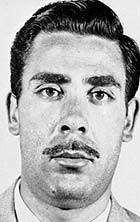
Tommaso Buscetta was a high ranking Italian mobster and a member of the Sicilian Mafia. He became one of the first of its members to turn informant and explain the inner workings of the organization.
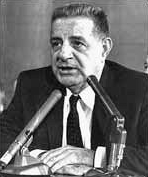
Joseph Michael Valachi was an American mobster in the Genovese crime family who was the first member of the Italian-American Mafia to acknowledge its existence publicly in 1963. He is credited with the popularization of the term cosa nostra.
"Mafia" is an informal term that is used to describe criminal organizations that bear a strong similarity to the Italian Mafia. The central activity of such an organization would be the arbitration of disputes between criminals as well as the organization and enforcement of illicit agreements between criminals through the use of or threat of violence. Mafias often engage in secondary activities such as gambling, loan sharking, drug-trafficking, prostitution, and fraud.
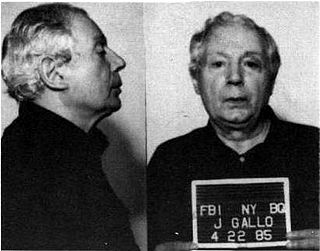
Joseph Nicholas Gallo was a New York mobster who served as consigliere of the Gambino crime family under three different bosses.
The Havana Conference of 1946 was a historic meeting of United States Mafia and Cosa Nostra leaders in Havana, Cuba. Supposedly arranged by Charles "Lucky" Luciano, the conference was held to discuss important mob policies, rules, and business interests. The Havana Conference was attended by delegations representing crime families throughout the United States. The conference was held during the week of December 22, 1946, at the Hotel Nacional. The Havana Conference is considered to have been the most important mob summit since the Atlantic City Conference of 1929. Decisions made in Havana resonated throughout US crime families during the ensuing decades.
The Sicilian Mafia or Cosa Nostra, also referred to as simply Mafia, is a criminal society originating on the island of Sicily and dates back to the mid-19th century. It is an association of gangs which sell their protection and arbitration services under a common brand. The Mafia's core activities are protection racketeering, the arbitration of disputes between criminals, and the organizing and oversight of illegal agreements and transactions.
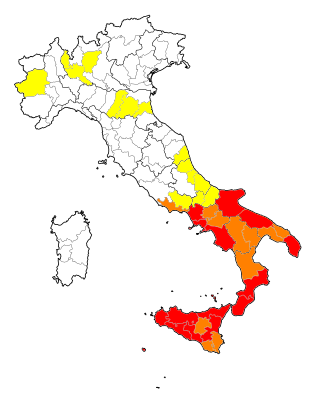
Criminal organizations have been prevalent in Italy, especially in the southern part of the country, for centuries and have affected the social and economic life of many Italian regions since at least the 19th century. There are six major native mafia-like organizations that are heavily active in Italy. The oldest and most powerful of these organizations, having begun to develop between 1500 and 1800, are the 'Ndrangheta from Calabria, the Cosa Nostra from Sicily, and the Camorra based in Campania. In addition to these three long-established organizations, there are also three other significantly active organized crime syndicates in Italy that were founded in the 20th century: the Stidda of Sicily and the Sacra Corona Unita and Società foggiana, both from Apulia.
Salvatore "Ciaschiteddu" Greco was a powerful mafioso and boss of the Sicilian Mafia in Ciaculli, an outlying suburb of Palermo famous for its citrus fruit groves, where he was born. His nickname, "Ciaschiteddu" or "Cicchiteddu", translates from the Sicilian alternatively as "little bird" or as "little wine jug".
Salvatore "Toto" D'Aquila was an early Italian-American Mafia boss in New York City of the D'Aquila crime family, what would later become known as the Gambino crime family.
A series of meetings between Sicilian Mafia and American Mafia members were allegedly held at the Grand Hotel et des Palmes in Palermo, Sicily, between October 12–16, 1957. Also called the 1957 Palermo Mafia summit, the summit discussed the international illegal heroin trade in the French Connection. The FBI believed it was this meeting that established the Bonanno crime family in the heroin trade.
William "Willie the Rat" Dominick Cammisano Sr. was an American mobster and enforcer for Nicholas Civella's Kansas City crime family.
Ralph "Little Ralphie" Scopo Sr. was a New York mobster with the Colombo crime family who became a powerful labor racketeer. He was the father of Colombo mobsters Joseph Scopo and Ralph Scopo Jr., and the grandfather of Joseph Scopo Jr. and Ralph Scopo III.
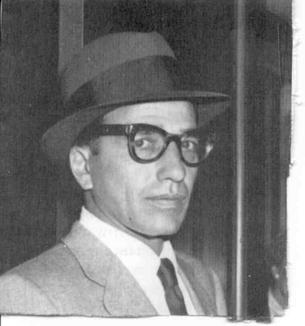
Vincent James Squillante, also known as Jimmy Jerome, was an American New York mobster who belonged to the Gambino crime family and was known as "king of the garbage collection racket". Squillante also worked as an assassin for mob boss Albert "Mad Hatter" Anastasia.
Vincent Cafaro was an Italian-American mobster who was a soldier in the Genovese crime family under the tutelage of acting boss Anthony "Fat Tony" Salerno, until becoming a government confidential informant and cooperating witness in 1986.

Nicola Gentile, also known as Nick Gentile, was a Sicilian mafioso and an organized crime figure in New York City during the 1920s and 1930s. He was also known for publishing his memoirs which, violating the mafiosi code known as omerta, revealed many details of the Sicilian and American underworld. Gentile was born in Siculiana, a small village on the south coast of Sicily in the province of Agrigento. He immigrated to the United States arriving in New York at age 18, in 1903. Gentile fled the country in 1937 while out on $15,000 bail after an arrest for heroin trafficking and returned to Sicily to become a boss in the Sicilian Cosa Nostra. In the US, he was known as "Nick" and in Sicily as "Zu Cola".
Gaspare Mutolo is a Sicilian mafioso, also known as "Asparino". In 1992 he became a pentito. He was the first mafioso who spoke about the connections between Cosa Nostra and Italian politicians. Mutolo's declarations contributed to the indictment of Italy's former Prime Minister Giulio Andreotti and to an understanding of the context of the 1992 Mafia murders of the politician Salvo Lima and the magistrates Giovanni Falcone and Paolo Borsellino.
The Valachi hearings, also known as the McClellan hearings, investigated organized crime activities across the United States. The hearings were initiated by Arkansas Senator John L. McClellan in 1963. Named after the major government witness against the American Mafia, foot soldier and made man Joseph Valachi, the trial exposed American organized crime to the world through Valachi's televised testimony. At the trial, Valachi was the first member of the Italian-American Mafia to acknowledge its existence publicly, and is credited with popularization of the term cosa nostra. The trial also exposed the hierarchy of the American Mafia, including the Five Families and The Commission.
The American Mafia, commonly referred to in North America as the Italian-American Mafia, the Mafia, or the Mob, is a highly organized Italian American criminal society and organized crime group.
This page lists books about mafia organizations all over the world:
References
- Sources included are Carl Sifakis's The Mafia Encyclopedia, Herbert Asbury's The Gangs of New York and others. Online references also include Thomas P. Hunt's Mafia Chronology, John Dickie's Cosa Nostra history and The Chronological History of La Cosa Nostra in the United States: January 1920 - August 1987 compiled by the United States Department of Justice Criminal Division's Organized Crime Intelligence and Analysis Unit.